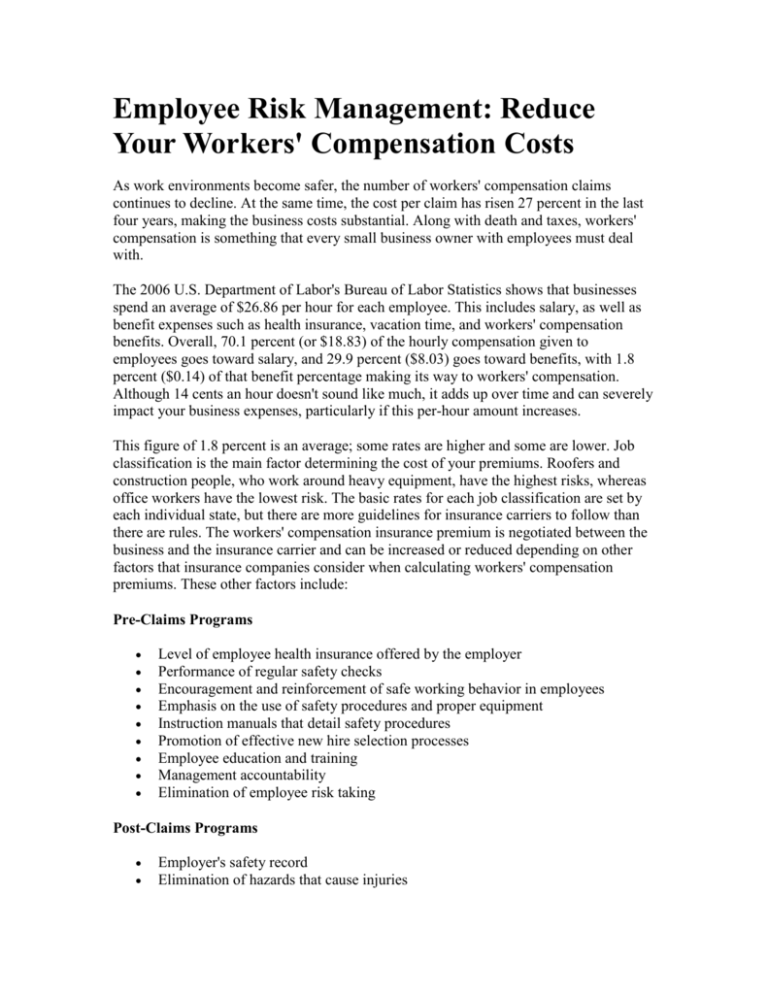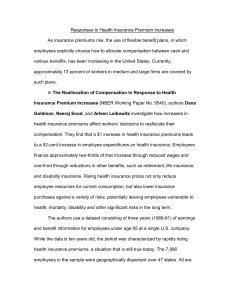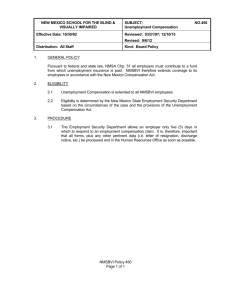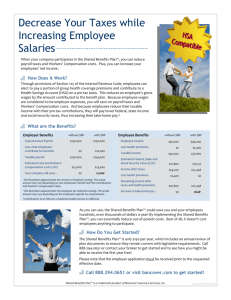Employee Risk Management
advertisement

Employee Risk Management: Reduce Your Workers' Compensation Costs As work environments become safer, the number of workers' compensation claims continues to decline. At the same time, the cost per claim has risen 27 percent in the last four years, making the business costs substantial. Along with death and taxes, workers' compensation is something that every small business owner with employees must deal with. The 2006 U.S. Department of Labor's Bureau of Labor Statistics shows that businesses spend an average of $26.86 per hour for each employee. This includes salary, as well as benefit expenses such as health insurance, vacation time, and workers' compensation benefits. Overall, 70.1 percent (or $18.83) of the hourly compensation given to employees goes toward salary, and 29.9 percent ($8.03) goes toward benefits, with 1.8 percent ($0.14) of that benefit percentage making its way to workers' compensation. Although 14 cents an hour doesn't sound like much, it adds up over time and can severely impact your business expenses, particularly if this per-hour amount increases. This figure of 1.8 percent is an average; some rates are higher and some are lower. Job classification is the main factor determining the cost of your premiums. Roofers and construction people, who work around heavy equipment, have the highest risks, whereas office workers have the lowest risk. The basic rates for each job classification are set by each individual state, but there are more guidelines for insurance carriers to follow than there are rules. The workers' compensation insurance premium is negotiated between the business and the insurance carrier and can be increased or reduced depending on other factors that insurance companies consider when calculating workers' compensation premiums. These other factors include: Pre-Claims Programs Level of employee health insurance offered by the employer Performance of regular safety checks Encouragement and reinforcement of safe working behavior in employees Emphasis on the use of safety procedures and proper equipment Instruction manuals that detail safety procedures Promotion of effective new hire selection processes Employee education and training Management accountability Elimination of employee risk taking Post-Claims Programs Employer's safety record Elimination of hazards that cause injuries Consistent internal policies and medical referral procedures Return-to-work programs By working with your risk management insurance carrier, you can implement both preand post-claims programs that will reduce your workers' compensation costs overall. Besides implementing procedures that make your business a more desirable client in terms of insurance rates, you can save even more on your risk management costs by implementing the following practices: Divide or reclassify an employee's payroll designation when an employee does more than one job. If an employee on a construction job worked as a roofer for half a day and then worked in the office for the other half, you might want divide his or her classification so that it accurately reflects the job. This will help you save money on premiums. When paying an employee time-and-a-half for overtime, you may only have to report the regular wages, decreasing the amount of payroll that determines your insurance premiums. Rising workers' compensation costs are primarily due to increased use of benefits and longer duration of disability. The more time an employee spends on disability, the more wage replacement and medical services increase in cost. Implement programs that bring workers back into the workforce at a faster rate, even if it means bringing them back part time or in a limited capacity. Look for a pattern to claims. Do some locations or areas in your business have fewer claims than others? Determine the reason why. Reducing the number of workers' compensation claims gives your business a better safety record. This makes you a much better risk to an insurance company, making it more likely they will give you better rates in the long run. Overall, this is the best way to reduce your risk management expenses. Be sure to read Understanding Workers' Compensation for more helpful information on this important topic.








